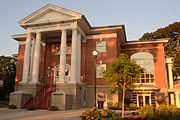
The Katharine Hepburn Cultural Arts Center, known as The Kate, is a performing arts center in Old Saybrook, Connecticut that opened in 2009. It is named for Katharine Hepburn, the 4-time Academy Award winning actress and Old Saybrook's most celebrated resident.

The Civic Institutions Historic District in New London, Connecticut is a historic district that was listed on the National Register of Historic Places in 1990. It includes six contributing buildings over a 7 acres (2.8 ha) area. The district includes properties that were historically developed between 1867 and 1917 to provide for the city's indigent population and to provide medical services to the community at large. Two of the buildings are almshouses, built in 1867 and 1917, and the others were historically associated with the delivery of medical services, and date to the turn of the 20th century. The district properties are 179 Colman Street, 32 Walden Avenue, and 156, 158, 171, and 173-5 Garfield Avenue.

Warren R. Briggs (1850–1933) was an American architect who worked in Bridgeport, Connecticut.

Harry S. Coombs (1878-1939) was an American architect practicing in Lewiston, Maine. He was the son of and successor to architect George M. Coombs.

Proudfoot & Bird was an American architectural firm that designed many buildings throughout the Midwest region of the United States. Originally established in 1882, it remains active through its several successors, and since 2017 has been known as BBS Architects | Engineers.

Haxby & Gillespie was an architectural firm from Fargo, North Dakota. R. J. Haxby and William D. Gillespie were the partners. The firm "produced a number of important buildings throughout North Dakota." They designed many notable public, educational, commercial, and church buildings, in North Dakota, Minnesota, and Montana.
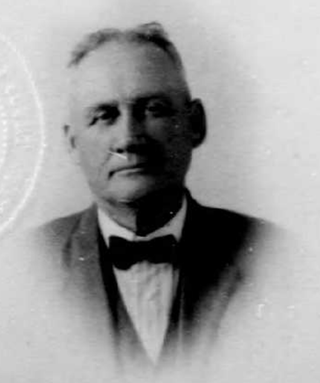
James Miller Creighton was an American architect who practiced in Phoenix, Arizona from the 1880s to the 1920s. He is considered to be one of Arizona's first architects.
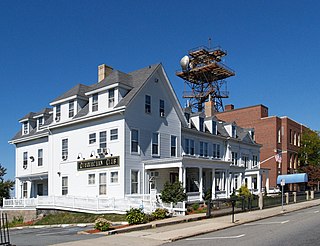
Nathaniel Cannon Smith (1866–1943), professionally known as Nat. C. Smith, was an American painter and architect of New Bedford, Massachusetts.
George Morrison Post was an American architect from Oregon. He worked primarily in Salem and Portland. A few of Post's works are listed on the National Register of Historic Places (NRHP).
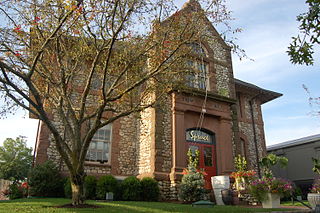
Ernest G. Southey was an American architect from Bridgeport, Connecticut.

Wilfred Elizur Griggs (1866–1918) was an American architect from Waterbury, Connecticut.

Stone, Carpenter & Sheldon was an American architectural firm based in Providence, Rhode Island. Established in 1906 and dissolved in 1926, it was the successor firm to Stone, Carpenter & Willson.

Frank Lyman Austin (1874-1942) was an American architect from Burlington, Vermont. He designed several buildings that have been placed on the National Register of Historic Places and others that are contributing buildings to listed historic districts.

Miller & Mayo, later Miller, Mayo & Beal, was a prominent architectural firm from Portland, Maine, established in Lewiston in 1907.

Cudworth & Woodworth, later Cudworth, Woodworth & Thompson and Cudworth & Thompson, was an architectural firm from Norwich, Connecticut.
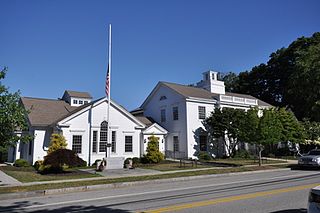
Morris B. Payne (1885-1961) was an American architect from New London, Connecticut. He was also major general in the Connecticut National Guard and commanded 43rd Infantry Division at the beginning of World War II.

Davis & Brooks was an American architectural firm based in Hartford, Connecticut, active from 1897 to 1919. It was established by F. Irvin Davis (1869-1944) and William F. Brooks (1872-1950). Among their projects is the Hartford Municipal Building, completed in 1915.
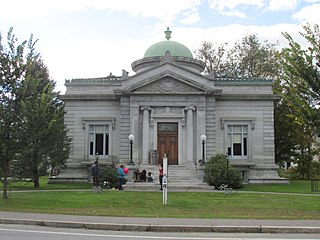
William H. McLean was an American architect from Boston, Massachusetts. He is best known for the design of public libraries, many of which he designed as a member of the firm of McLean & Wright.

Dudley St. Clair Donnelly (1870-1937) was an American architect practicing in New London, Connecticut in the late nineteenth and early twentieth centuries.
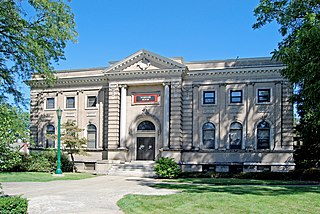
Penn Varney (1859–1949) was an American architect in practice in Lynn, Massachusetts, during the late nineteenth and early twentieth centuries.



